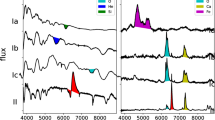Abstract.
Bright and homogeneous, thermonuclear, or type Ia, supernovae (SNeIa) are our best extragalactic distance indicators. Since the 60s, SNeIa have been used as cosmological tools, initially, to estimate the current expansion rate of the Universe, the Hubble constant. Decades ago SNeIa were discovered by chance, in many cases by amateurs. Advances in the instrumentation, techniques and new observational strategies allowed in the 80s to discover SNe in scheduled surveys. Moreover, through calibration relations, a high precision in extragalactic distance determinations was achieved, allowing SNIa observations to reveal the dynamics of the Universe. The Nobel prize in Physics in 2011 was awarded to the leaders of two independent teams “for the discovery of the accelerating expansion of the Universe through observations of distant supernovae”. This is a brief and incomplete story of SNeIa as cosmological tools. In the Madrasah of Granada (Spain), built in 1349 by the Nasrid monarch Yosuf the 1st, Astronomy was one of the disciplines included in the studies. On the Madrasah walls, a calligraphic decoration reads: “make study shine like stars”. It is a good motto for our 4th Azarquiel School of Astronomy.
Similar content being viewed by others
References
D. Branch, G.A. Tammann, Annu. Rev. Astron. Astrophys. 30, 359 (1992)
F. Hoyle, W.A. Fowler, Astrophys. J. 132, 565 (1960)
M.M. Phillips, Astrophys. J. Lett. 413, L105 (1993)
M.M. Phillips, P. Lira, N.B. Suntzeff et al., Astron. J. 118, 1766 (1999)
G. Goldhaber et al., Astrophys. J. 558, 359 (2001)
A. Riess et al., Astron. J. 116, 1009 (1998)
S. Perlmutter et al., Astrophys. J. 517, 565 (1999)
A. Riess et al., Astrophys. J. 607, 665 (2004)
M. Hamuy, M.M. Phillips, N.B. Suntzeff, R.A. Schommer, J. Maza, R. Aviles, Astron. J. 112, 2391 (1996)
D. Branch, W. Romanishin, E. Baron, Astrophys. J. 465, 73 (1996)
M. Sullivan et al., Mon. Not. R. Astron. Soc. 406, 782 (2010)
H. Lampeitl et al., Astrophys. J. 722, 566 (2010)
M. Betoule et al., Astron. Astrophys. 568, A22 (2014)
M.-E. Moreno-Raya et al., Mon. Not. R. Astron. Soc. 462, 1281 (2016)
Author information
Authors and Affiliations
Corresponding author
Rights and permissions
About this article
Cite this article
Domínguez, I., Galbany, L. Thermonuclear supernovae and cosmology⋆. Eur. Phys. J. Plus 133, 323 (2018). https://doi.org/10.1140/epjp/i2018-12176-9
Received:
Accepted:
Published:
DOI: https://doi.org/10.1140/epjp/i2018-12176-9




